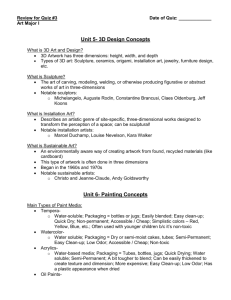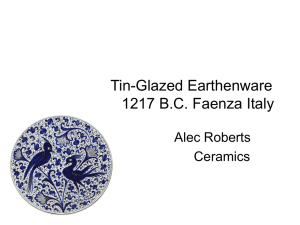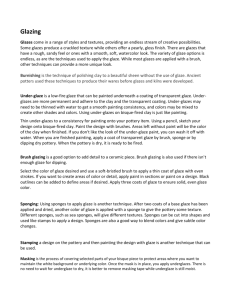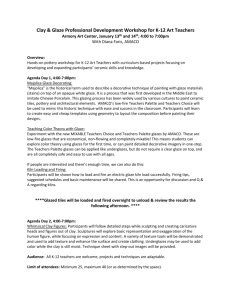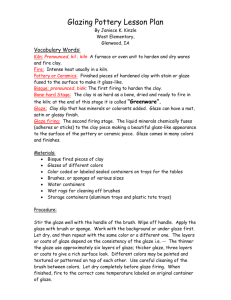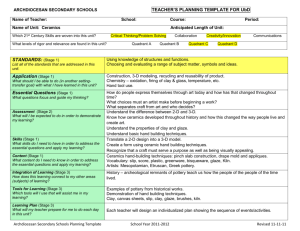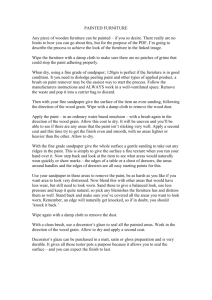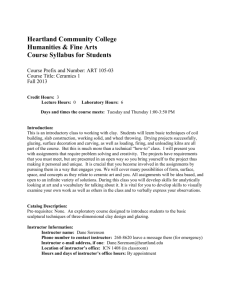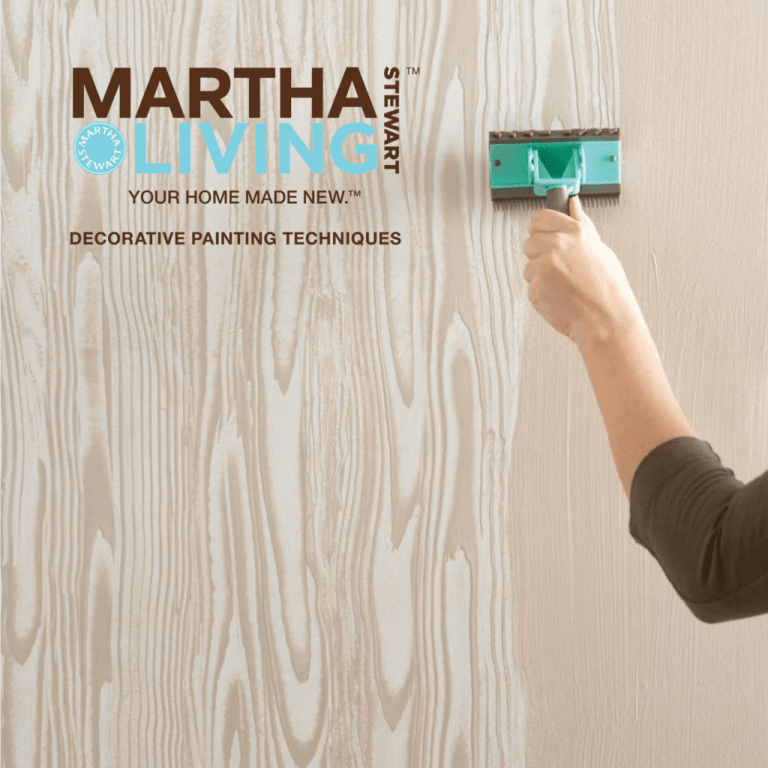
YOUR HOME MADE NEW.™
DECORATIVE PAINTING TECHNIQUES
BASKET WEAVE, 5-6
FAUX BOIS, 7-8
GINGHAM, 9
PLAID, 11-12
HERRINGBONE, 13
CURLY MAPLE, 14
SPONGE-ON, 17
SPONGE-OFF, 17
LARGE STRIPES, 18
12 VERY SPECIAL EFFECTS
RAW SILK, 10-11
A fresh coat of paint does wonders in a room, but to really
breathe new life into plain walls and tired furniture, try giving
that fresh coat a little something extra. Eye-catching patterns
and surface textures are surprisingly easy to create yourself,
and you can see the beautiful results of your project in the space
of a single weekend.
This booklet give you step-by-step instructions for producing
a dozen professional-looking effects, including graphic stripes,
rich textured linen, and my favorite “faux bois” wood grain. All
you need are some easy-to-mix tinted glazes—you’ll apply these
LINEN, 15-16
on top of a base coat of Martha Stewart Living™ Paint—and a
few simple tools to manipulate the glaze (included in our Paint
Finish Tool Kit).
Practice your technique on a smaller project first, like an old chair
or a nondescript headboard, or even on a small piece of drywall,
then try your hand at decorating a wall. Once you’ve discovered
how easy it is, you’ll see that the creative possibilities are endless!
IRREGULAR STRIPES, 18
PREPARING
THE SURFACE
Whether you’re decorating a small furniture piece or an entire room, each technique
requires that the surface be prepared and painted with an undercoat of satin-finished
paint. This is called the base coat, and it should coordinate with the glaze color.
1 CLEAN THE SURFACE
with a pre-mixed TSP (trisodium phosphate) or TSPsubstitute (TSP-PF), especially if it has a glossy finish or is extremely dusty. If it is
relatively clean, simply wipe it down with a damp sponge.
2
PATCH HOLES with a spackling paste or patching product like Drydex. Apply
a small amount to the hole using a putty knife. Smooth the product over the hole
and allow it to dry (Drydex will be pink when applied and will turn white as it dries).
Once it has dried completely, lightly sand the area to a smooth, even finish.
3
TAPE OFF AREA . Mask off moldings, switch plates, etc. with Blue Painter’s
Tape. Pull tape off the roll a few feet at a time and press down with your fingers
as you apply it; avoid stretching the tape, which can cause it to lift or break. If the
surface is highly textured, seal the tape edge with the existing base color to prevent
seepage under the tape.
4 PRIME THE SURFACE
if you are painting over a dark color, stains, or existing
wallpaper. In most situations, a latex primer will do; in order to cover water-based
stains, however, you will need to use an oil-based primer.
5 PAINT THE BASE COAT
using satin-finished Martha Stewart Living latex
interior paint. Allow at least 24 hours for paint to dry completely.
6 DIVIDE WALLS
into even, workable sections, using a level to draw light pencil
guidelines from floor to ceiling every 18” (use a colored pencil similar to your glaze
color). These will help keep vertical lines and strokes from straying too much.
3
P R E PA R I N G T H E S U R FA C E
HOW TO
MAKE A GLAZE
The secret to the decorative paint techniques in this booklet lies in the glaze,
a luminescent, translucent layer that allows a base coat of opaque paint to show through.
It’s easy to create simple, beautiful glazes in whatever colors you like. Just purchase
the latex or acrylic glazing liquid of your choice, then mix it with your selected Martha
Stewart Living paint color according to the manufacturer’s instructions.
USING PRACTICE BOARDS
To make sure that you feel comfortable with a skill and happy with the result, it’s a
good idea to test any paint technique on a small board before starting on your furniture or wall. Purchase a 2’ x 2’ drywall board, available at The Home Depot, then
mix mini-batches of glaze using Martha Stewart Living Tintable Testers or Martha
Stewart Living Pre-Tinted Testers in our “Martha’s Picks” colors. This is also a good
opportunity to test combinations of colors and choose those that work best before
making your final paint purchase.
*
TIPS FOR CREATING COLOR EFFECTS
*
There should be enough contrast between the base coat and the glaze color
to make the glaze visible, but not a jarring contrast.
*
Most often, a glaze that is a slightly darker or deeper shade of the base
coat color works best to create a sense of harmony and depth.
*
For a more powerful look, try using colors that are next to each other in the
spectrum, such as green over blue.
*
Another approach, known as a scumble, uses a lighter color over a deeper base.
Martha Stewart Living™, Your Home Made New™, and the Martha Stewart Circle Logo™ are trademarks of
Martha Stewart Living Omnimedia, Inc. Copyright© 2010 Martha Stewart Living Omnimedia, Inc. All rights reserved.
Visit homedepot.com/marthastewart for more paint ideas.
HOW TO MAKE A GLAZE
4
OUR FAVORITE
TECHNIQUES
BASKET WEAVE
Resembling a large checkerboard, basket weave is a beautiful way to add
dimension and a sense of movement to a plain wall.
FOR THIS TECHNIQUE, USE THE GRAINING COMB, EVEN SIDE
Before beginning, complete the base coat according to instructions on page 3.
1 TAPE OFF SURFACE
A
Start at the center of your surface and mark out the grid so that partial squares appear
only at the edges (or if possible, divide your wall into a whole number of sections that
leave no partial squares, such as 2’ squares on a 12’ x 12’ wall). Tape off alternating
squares so that the tape from one square doesn’t overlap another. (A) Burnish the tape
with your finger to remove any wrinkles or bubbles. Pencil a light mark or note in each
square to remind yourself to alternate the direction of the combed stripes.
2 MIX GLAZE
Prepare your glaze according to the manufacturer’s instructions.
3 APPLY GLAZE
Using a 3” bristle brush, apply a thin layer of glaze to one square, in strokes parallel to the direction the stripes will run (vertically for vertical squares, horizontally for
horizontal squares). (B)
4 CREATE VERTICAL SQUARES
B
Drag the even-toothed side of the Graining Comb through the glaze from top to bottom, maintaining firm pressure so the striations are clean and crisp. (C) Start each
pass with little or no overlap to the previous. Use a balled-up paper towel to remove
excess paint from the comb. When the square is filled, carefully remove the tape
around that square. Clean away any large areas of seepage under the tape. Repeat
Steps 3 and 4 for all vertical squares, then let dry completely.
*
TIP: If you’re concerned about damaging the effect by removing the tape
when wet, let the surface dry completely, then remove the tape. You’ll need to touch
up any dried seepage with paint.
5 CREATE HORIZONTAL SQUARES
Use 1-inch painter’s tape to cover the edges of the finished squares. Repeat Steps 3
and 4, this time dragging the comb horizontally through the remaining squares.
C
YOU’LL
ALSO NEED:
3” BRISTLE BRUSH
Visit homedepot.com/marthastewart for more paint ideas.
+
PAPER TOWEL
+
1”-WIDE LOW-TACK
PAINTER’S TAPE
BASKET WEAVE
6
FAUX BOIS
French for “false wood”, faux bois mimics the look of wood grain, and it’s
one of our favorite motifs. With a few simple tools, you can paint a realistic
cathedral oak pattern that is elegant yet natural.
FOR THIS TECHNIQUE, USE THE WOOD GRAIN
ROCKER & GRAINING COMB, UNEVEN SIDE
A
Before beginning, complete the base coat according to instructions on page 3.
1 MIX GLAZE
Prepare your glaze according to the manufacturer’s instructions.
2 APPLY GLAZE
Working in small sections that run the length of the wall, apply a thin layer of glaze using a
roller with ¼” nap (use a 3” bristle brush on small surfaces).(A)
3 CREATE THE EFFECT
B
Hold the Wood Grain Rocker firmly and, while maintaining pressure, drag it vertically
through the glaze, gradually rolling the tool once from tip to end by the time you reach the
bottom. (B) The speeds at which you drag and roll will determine the distance between the
arched lines of the cathedral grain. Use a balled-up paper towel to remove excess paint
from the tool. Flip the rocker in the opposite direction (to change the direction of the grain)
and repeat the process to create a second panel next to the first.
4 ADD STRAIGHT GRAINS
For a more realistic look, drag the uneven edge of either the Graining Comb or the
Wood Grain Rocker alongside the previous panel. Alternate 2 or 3 rows of cathedral
grain with 2 rows of straight grain. (C)
REPEAT STEPS 3 AND 4 until you near the end of the section, then apply glaze for
the next section and continue. Allow finished wall to dry thoroughly.
YOU’LL
ALSO NEED:
C
7
FA U X B O I S
9” ROLLER, ¼” NAP
OR 3” BRISTLE BRUSH
+
Visit homedepot.com/marthastewart for more paint ideas.
PAPER TOWEL
See Gingham instructions on page 9.
FA U X B O I S & G I N G H A M
8
GINGHAM
A cheerful gingham pattern can be a sweet choice for a kitchen
or a child’s bedroom, and a simple two-directional combing technique
makes it very easy to accomplish.
A
FOR THIS TECHNIQUE, USE THE FLEXIBLE
STRIPE COMB & STRIPE COMB
Before beginning, complete the base coat according to instructions on page 3.
1 MIX GLAZE
Prepare your glaze according to the manufacturer’s instructions.
2 APPLY GLAZE
Working in small sections that run the length of the wall, apply a thin layer of glaze using
a roller with ¼” nap (use a 3” bristle brush on small surfaces). (A)
3 CREATE VERTICAL STRIPES
B
Beginning at one edge of the section, drag the Stripe Comb through the glaze from top
to bottom. (B) Maintain firm pressure so the stripes are clean and crisp. Use a balledup paper towel to remove excess paint from the comb, then begin the next pass with
little or no overlap to the first. Repeat until you get to within a couple of inches of the
end of the section, then apply glaze for the next section and continue. (For narrow
room spaces, such as between walls and door frames, or for curved furniture surfaces,
switch to the smaller Flexible Stripe Comb, which has teeth the same size as the wider
comb.) Allow finished surface to dry thoroughly.
4 CREATE HORIZONTAL STRIPES
Repeat steps 1 through 3, this time dragging the comb horizontally across the surface to complete the gingham pattern. (C) If painting a wall, start at the top to avoid
dripping on finished work.
C
9
GINGHAM
YOU’LL
ALSO NEED:
9” ROLLER, ¼” NAP
OR 3” BRISTLE BRUSH
+
PAPER TOWEL
RAW SILK
This strié technique uses coarse steel wool, which causes the paint to pool in
small, irregular formations resembling the slubs that are characteristic of raw silk.
To enhance the illusion, try using iridescent paint when creating your glaze.
A
FOR THIS TECHNIQUE, USE THE COARSE STEEL WOOL
Before beginning, complete the base coat according to instructions on page 3.
1 MIX GLAZE
Prepare your glaze according to the manufacturer’s instructions.
2 APPLY GLAZE
Working in small sections that run the length of the wall, apply a thin layer of glaze
using a roller with ¼” nap (use a 3” bristle brush on small surfaces). (A)
3 CREATE THE EFFECT
B
C
Unroll the Coarse Steel Wool and ball it up loosely so that you have a large piece without sharp edges. Beginning at one edge of the section, drag the steel wool through
the glaze from top to bottom. (B) Maintain firm pressure so the striations are clean and
crisp. Use a balled-up paper towel to remove excess paint from the steel wool (C) ,
then begin the next pass, slightly overlapping the first. Repeat until you get to within
a couple of inches of the end of the section, then apply glaze for the next section and
continue. Allow finished surface to dry thoroughly. Note: You will need extra steel
wool to complete large surfaces.
YOU’LL
ALSO NEED:
Visit homedepot.com/marthastewart for more paint ideas.
9” ROLLER, ¼” NAP
OR 3” BRISTLE BRUSH
+
PAPER TOWEL
RAW SILK
10
See previous page for Raw Silk Instructions.
11
PLAID & RAW SILK
PLAID
Plaid involves creating stripes in two colors and in two directions. The
uneven side of the Wood Grain Rocker gives the stripes an irregular width.
A
FOR THIS TECHNIQUE, USE THE STRIPE COMB AND THE WOOD GRAIN ROCKER, UNEVEN SIDE
Before beginning, complete the base coat according to instructions on page 3.
1 MIX GLAZE
Prepare your glaze according to the manufacturer’s instructions.
2 APPLY GLAZE
Working in small sections that run the length of the wall, apply a thin layer of glaze
using a roller with ¼” nap (use a 3” bristle brush on small surfaces). (A)
3 CREATE VERTICAL STRIPES
B
Beginning at one edge of the section, drag the Stripe Comb through the glaze from top
to bottom. (B) Maintain firm pressure so the stripes are clean and crisp. Use a balled-up
paper towel to remove excess paint from the brush, then begin the next pass with little
or no overlap to the first. Repeat until you get to within a couple of inches of the end
of the section, then apply glaze for the next section and continue. Allow the finished
surface to dry thoroughly.
4 CREATE HORIZONTAL STRIPES
Repeat steps 2 through 3 with your second glaze color, this time dragging the Wood
Grain Rocker horizontally across the surface to complete the plaid pattern. (C) If painting a wall, start at the top to avoid dripping on finished work.
C
YOU’LL
ALSO NEED:
9” ROLLER, ¼” NAP
OR 3” BRISTLE BRUSH
Visit homedepot.com/marthastewart for more paint ideas.
+
PAPER TOWEL
PLAID
12
HERRINGBONE
Alternating stripes made up of perpendicular striations create the classic
herringbone texture commonly found in twill fabrics. Careful taping is the
secret to a successful herringbone technique.
FOR THIS TECHNIQUE, USE THE GRAINING COMB, EVEN SIDE
Before beginning, complete the base coat according to instructions on page 3.
A
1 TAPE OFF SURFACE
Affix a strip of 1-inch-wide painter’s tape down the length of the surface, starting at the
center. Affix two more strips on either side of the first, then remove middle strip. Continue
taping off, using the middle strip as a spacer, until surface is covered with strips of tape 1
inch apart. (A) Burnish the tape with your finger to remove any wrinkles or bubbles.
2 MIX GLAZE
Prepare your glaze according to the manufacturer’s instructions.
3 APPLY GLAZE
Using a 3” bristle brush, apply a thin layer of glaze in strokes at first parallel to the strips
of tape, and then with a final stroke on a 45-degree angle to them.
4 COMB IN FIRST DIRECTION
B
Drag the even-toothed side of the Graining Comb along this same 45-degree angle to
the tape, maintaining firm pressure so the striations are clean and crisp. (B) Start each
pass with little or no overlap to the previous. Use a balled-up paper towel to remove
excess paint from the comb. When finished, carefully remove the tape and clean away
any large areas of seepage under it.
5 REPEAT IN SECOND DIRECTION
Use 1-inch painter’s tape to cover the finished stripes (you won’t need spacers). (C)
Apply glaze at first parallel to the tape, and then with a final stroke PERPENDICULAR to
the previously painted stripes. Drag the Graining Comb along this same new 45-degree
angle, and proceed as in Step 4.
*
TIP: If you’re concerned about damaging the effect by removing the tape
when wet, let the surface dry completely, then remove the tape. You’ll need to touch
up any dried seepage with paint.
C
13
HERRINGBONE
YOU’LL
ALSO NEED:
3” BRISTLE BRUSH
+
PAPER TOWEL
+
1”-WIDE LOW-TACK
PAINTER’S TAPE
CURLY MAPLE
Curly maple features a striking pattern of thin waves or stripes and is famously
used on musical instruments and fine furniture. Our Wavy Graining Brush lets
you create this characteristic figuring effect for yourself.
FOR THIS TECHNIQUE, USE THE WAVY GRAINING BRUSH
Before beginning, complete the base coat according to instructions on page 3.
A
1 MIX GLAZE
Prepare your glaze according to the manufacturer’s instructions.
*
TIP: This effect often works better with a slightly thinner glaze. Test it on your
practice board, and if necessary, thin the glaze with water.
2 APPLY GLAZE
Working in small sections that run the length of the wall, apply a thin layer of glaze using
a roller with ¼” nap (use a 3” bristle brush on small surfaces). (A)
3 CREATE THE EFFECT
B
Hold the Wavy Graining Brush at an angle to the surface. Starting at one edge of the
section, pull the brush down through the glaze in short, abrupt motions about ¼ to ½
inch long. Lift the brush off the surface at times to create a higher-contrast stroke, and
occasionally twist the brush a bit to keep strokes from becoming too regular. (B) Continue
this motion for the length of the surface, then start a new row, overlapping the marks
slightly so the rows merge together. Use a balled-up paper towel to remove excess
paint from the brush.
4 BLEND THE STROKES
When you’ve finished the section, blend the figuring with a dry soft-bristle brush to create its soft, watery effect: hold the brush perpendicular to the surface and brush very
lightly across and then down. (C)
REPEAT STEPS 3 AND 4 until you get to within a couple of inches of the end of
the section, then apply glaze for the next section and continue. Allow finished surface
to dry thoroughly.
C
YOU’LL
ALSO NEED:
9” ROLLER, ¼” NAP
OR 3” BRISTLE BRUSH
Visit homedepot.com/marthastewart for more paint ideas.
+
PAPER TOWEL
+
ADDITIONAL DRY
SOFT-BRISTLE BRUSH
C U R LY M A P L E
14
15
LINEN
Creating the illusion of a linen weave is as simple as applying a “strié” technique in
two directions with a long-bristled brush called a Linen Dragger. The resulting lines
or “striations” in the glaze coat resemble the fabric’s warp and weft threads.
A
FOR THIS TECHNIQUE, USE THE LINEN DRAGGER
Before beginning, complete the base coat according to instructions on page 3.
1 MIX GLAZE
Prepare your glaze according to the manufacturer’s instructions.
2 APPLY GLAZE
Working in small sections that run the length of the wall, apply a thin layer of glaze using a
roller with ¼” nap (use a 3” bristle brush on small surfaces).(A)
3 CREATE VERTICAL THREADS
B
Beginning at one edge of the section, drag the Linen Dragger through the glaze from
top to bottom. (B) Press down to use the full length of the bristles, and maintain this firm
pressure so the striations are clean and crisp. Use a balled-up paper towel to remove
excess paint from the brush, then begin the next pass, slightly overlapping the first. Repeat until you get to within a couple of inches of the end of the section, then apply glaze
for the next section and continue. Allow finished surface to dry thoroughly.
4 CREATE HORIZONTAL THREADS
Once your vertical coat is completely dry, apply a thin layer of glaze on top of it as you
did in step 2, but this time work in horizontal sections (starting at the top of the wall to
avoid dripping on finished work). Repeat step 3, dragging the brush horizontally across
the surface to complete the woven effect. (C)
*
TIP: Test the second coat of glaze on the same practice board where
you first tested your linen technique. If it appears to cover too much of the first coat,
thin the glaze slightly with water.
C
YOU’LL
ALSO NEED:
Visit homedepot.com/marthastewart for more paint ideas.
9” ROLLER, ¼” NAP
OR 3” BRISTLE BRUSH
+
PAPER TOWEL
+
1”-WIDE LOW-TACK
PAINTER’S TAPE
LINEN
16
SPONGE-ON
Applying glaze with a natural sea sponge is a simple, effective way to give
a plain wall added texture and depth. Depending on the number of glazes you
use and how you apply them, the possible variations are endless.
FOR THIS TECHNIQUE, USE THE PAINTING SPONGE
Before beginning, complete the base coat according to instructions on page 3.
A
1 MIX GLAZE
Prepare your glaze according to the manufacturer’s instructions.
2 CREATE THE EFFECT
Dampen the Painting Sponge in water and squeeze out the excess. Pour a small amount
of glaze onto a paint tray. Dip the sponge into the glaze and blot off excess along the
edge of the tray. (A) Dab the sponge onto the dry, painted wall; be sure to vary your pattern by twisting and turning sponge with each dab. ( B ) Use a small piece of sponge or
cotton swabs to get into corners and tight spaces. Try to keep the pattern consistent
and even; step back frequently to judge its uniformity.
3 USING MULTIPLE GLAZES
(OPTIONAL)
A good way to achieve extra depth is by using several tones of the same color. If you
plan to use more than one glaze color, sponge the entire surface with the first color
and let it dry, then proceed to the next color, using a clean tray and sponge for each
one. (C) Remember that the last color you apply will be the most visible one.
B
SPONGE-OFF
You can also remove glaze with the sponge rather than applying it. Working in small
sections, apply a thin layer of glaze using a roller or bristle brush. Dampen the sponge
in water and squeeze out the excess. Dab the clean sponge onto the wall to lift away
the glaze from the undercoat, twisting and turning with each dab as in the Sponge-On
technique. Rinse out the sponge periodically. Continue until you get to within a couple of
inches of the end of the section, then apply glaze for the next section.
FOR THIS TECHNIQUE USE THE PAINTING SPONGE
C
+
YOU’LL
ALSO NEED:
PAINT TRAY
17
SPONGE-ON & SPONGE-OFF
+
COTTON SWABS
9” ROLLER, ¼” NAP OR 3” BRISTLE
BRUSH (FOR SPONGE-OFF ONLY)
LARGE
STRIPES
FOR THIS TECHNIQUE, USE THE FLEXIBLE STRIPE COMB & STRIPE COMB
Before beginning, complete the base coat according to instructions on page 3.
A
1 MIX GLAZE
Prepare your glaze according to the manufacturer’s instructions.
2 APPLY GLAZE
Working in small sections that run the length of the wall, apply a thin layer of glaze using
a roller with ¼” nap (use a 3” bristle brush on small surfaces). (A)
3 CREATE THE EFFECT
Hold the Stripe Comb firmly and drag it vertically through the glaze, maintaining pressure
so lines are clean and crisp. (B) Use a balled-up paper towel to remove excess paint from
the comb. (C) Repeat until you get to within a couple of inches of the end of the section,
then apply glaze for the next section and continue. For narrow spaces, such as between
walls and door frames, or for curved furniture surfaces, switch to the smaller Flexible
Stripe Comb, which has teeth the same size as the wider comb. Allow finished surface
to dry thoroughly.
B
*
TIP: For this and other stripe techniques, use a small artist’s brush to touch up lines
that are not well defined.
IRREGULAR STRIPES
You can create irregular stripes by following the same application steps above. Simply
use the uneven-toothed side of the Wood Grain Rocker instead of the Stripe Combs.
FOR THIS TECHNIQUE USE THE WOOD GRAIN ROCKER, UNEVEN SIDE
C
YOU’LL
ALSO NEED:
Visit homedepot.com/marthastewart for more paint ideas.
9” ROLLER, ¼” NAP
OR 3” BRISTLE BRUSH
+
PAPER TOWEL
LARGE STRIPES & IRREGULAR STRIPES
18
PAINT COLOR INDEX
Listed below are the Martha Stewart Living™ paint colors used throughout
this brochure, so you can easily find your favorites at The Home Depot.
COVER
CURLY MAPLE
BASE
LAMB MSL225
BASE
LAMB MSL225
GLAZE
POTTER’S CLAY MSL239
GLAZE
SHARKEY GRAY MSL240
BASKET WEAVE
(pages 5-6)
LINEN
(pages 15-16)
BASE
SHARKEY GRAY MSL240
BASE
CARNATION MSL005
GLAZE
MOLASSES MSL245
GLAZE
NUTSHELL MSL213
FAUX BOIS
(pages 7-8)
BASE
AEGEAN BLUE MSL118
GLAZE
DUCK’S EGG MSL133
GINGHAM
(pages 8-9)
SPONGE-ON
(page 17)
BASE
SHARKEY GRAY MSL240
GLAZE
CREVECOEUR MSL249
HEATH MSL212
SPONGE-OFF
(table of contents)
BASE
MOONGLOW MSL085
BASE
CARNATION MSL005
GLAZE
BAY LEAF MSL105
GLAZE
SILK LINING MSL021
RAW SILK
(pages 10-11)
LARGE STRIPES
(page 18)
BASE
YELLOW GERBERA MSL062
BASE
GULL MSL256
GLAZE
MALTED MSL071
GLAZE
CORNFLOWER BLUE MSL153
PLAID
(pages 11-12)
BASE
CUSTARD MSL068
GLAZE
SULTANA MSL101
HEATH MSL212
HERRINGBONE
19
(page 14)
(table of contents)
BASE
SHARKEY GRAY MSL240
GLAZE
VIOLET ASTER MSL187
(page 13)
BASE
TOILE BLUE MSL157
GLAZE
BLUEBIRD MSL158
PA I N T C O L O R I N D E X
IRREGULAR STRIPES
Visit homedepot.com/marthastewart for more paint ideas.


